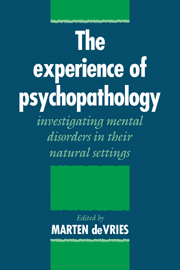Book contents
- Frontmatter
- Contents
- Foreword
- Preface
- PART I INTRODUCTION: THE EXPERIENCE OF PSYCHOPATHOLOGY
- PART II THE EXPERIENCE SAMPLING METHOD: PROCEDURES AND ANALYSES
- 4 Validity and reliability of the Experience Sampling Method
- 5 Analyzing Experience Sampling data: a guide book for the perplexed
- 6 States, syndromes, and polythetic classes: developing a classification system for ESM data using the ascending and cross-classification method
- PART III EXPERIENCE SAMPLING STUDIES WITH CLINICAL SAMPLES
- PART IV THERAPEUTIC APPLICATIONS OF THE EXPERIENCE SAMPLING METHOD
- PART V PSYCHIATRIC RESEARCH APPLICATIONS: PRACTICAL ISSUES and ATTENTION POINTS
- CLOSING Looking to the future
- References
- List of contributors
- Index
5 - Analyzing Experience Sampling data: a guide book for the perplexed
from PART II - THE EXPERIENCE SAMPLING METHOD: PROCEDURES AND ANALYSES
Published online by Cambridge University Press: 03 May 2010
- Frontmatter
- Contents
- Foreword
- Preface
- PART I INTRODUCTION: THE EXPERIENCE OF PSYCHOPATHOLOGY
- PART II THE EXPERIENCE SAMPLING METHOD: PROCEDURES AND ANALYSES
- 4 Validity and reliability of the Experience Sampling Method
- 5 Analyzing Experience Sampling data: a guide book for the perplexed
- 6 States, syndromes, and polythetic classes: developing a classification system for ESM data using the ascending and cross-classification method
- PART III EXPERIENCE SAMPLING STUDIES WITH CLINICAL SAMPLES
- PART IV THERAPEUTIC APPLICATIONS OF THE EXPERIENCE SAMPLING METHOD
- PART V PSYCHIATRIC RESEARCH APPLICATIONS: PRACTICAL ISSUES and ATTENTION POINTS
- CLOSING Looking to the future
- References
- List of contributors
- Index
Summary
This chapter provides a guidebook for doing simple analysis with the complex-data obtained by experience sampling. We describe the basic types of questions investigators may ask, and discuss the strength and limitations associated with different approaches to testing these questions. Because ESM data reflect the complexities of everyday life, no analysis can fully capture the underlying trends, and few analyses will fully meet the assumptions of statistical tests. Nonetheless, we argue that careful and creative analysis of ESM data can provide provocative information about the daily lives of a research population.
‘Danger, lives have been lost!’ reads a sign on the rocks by a raging cascade near one of the authors' places of birth. A similar warning should accompany Experience Sampling data, for a novice could easily squander many years on the slippery terrain of ESM data analysis. Such a warning should be in bright neon for students trained in the positivist framework of experimental science; like the daily experience they attempt to mirror, ESM data have a complexity which defies traditional textbook analysis. Rarely do they fully oblige the stringent assumptions of inferential statistical tests. The many factors impinging on daily life, and thus upon these data, demand a constant vigilance to statistical artifact and possible confounds. Therefore, even the seasoned ESM researcher takes many trips back to the computer before finalizing an analysis in a way that most clearly expresses the relationship he or she wishes to capture.
Information
- Type
- Chapter
- Information
- The Experience of PsychopathologyInvestigating Mental Disorders in their Natural Settings, pp. 58 - 78Publisher: Cambridge University PressPrint publication year: 1992
Accessibility standard: Unknown
- 46
- Cited by
